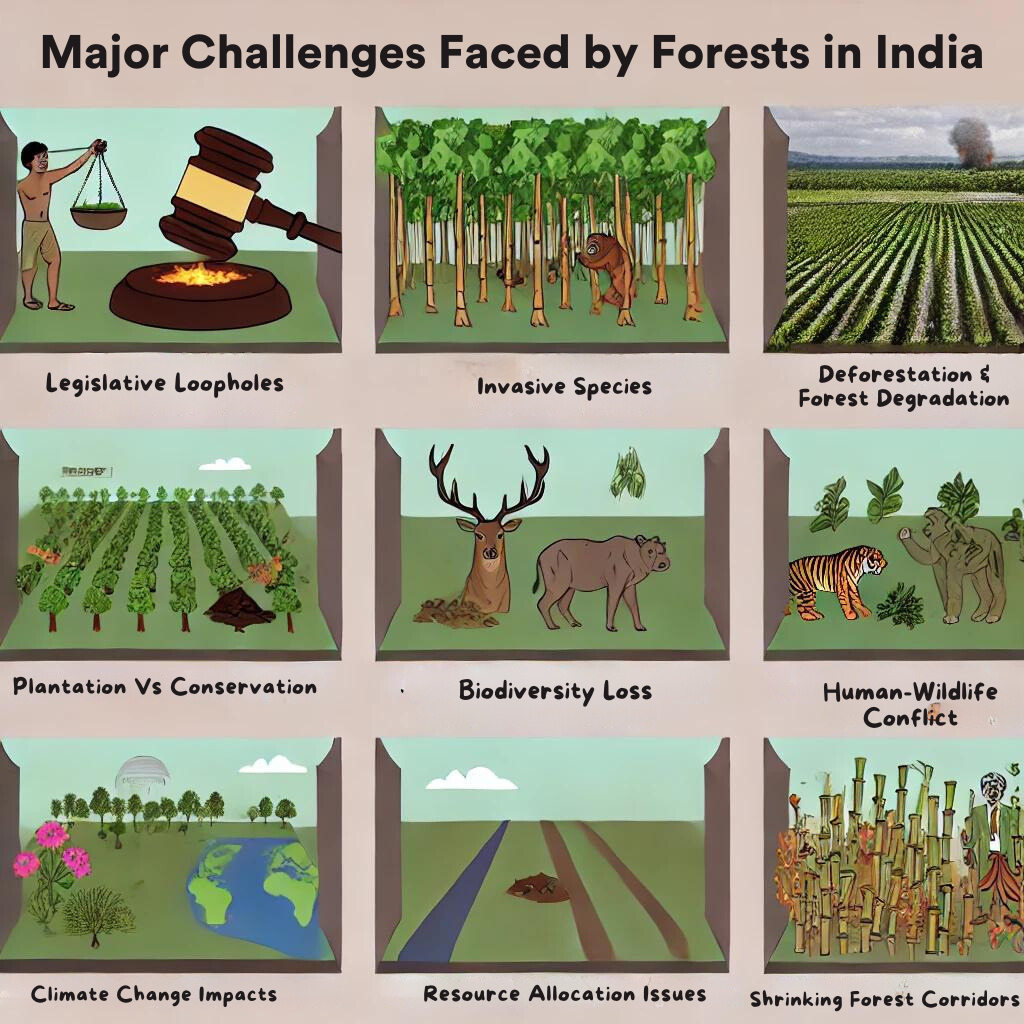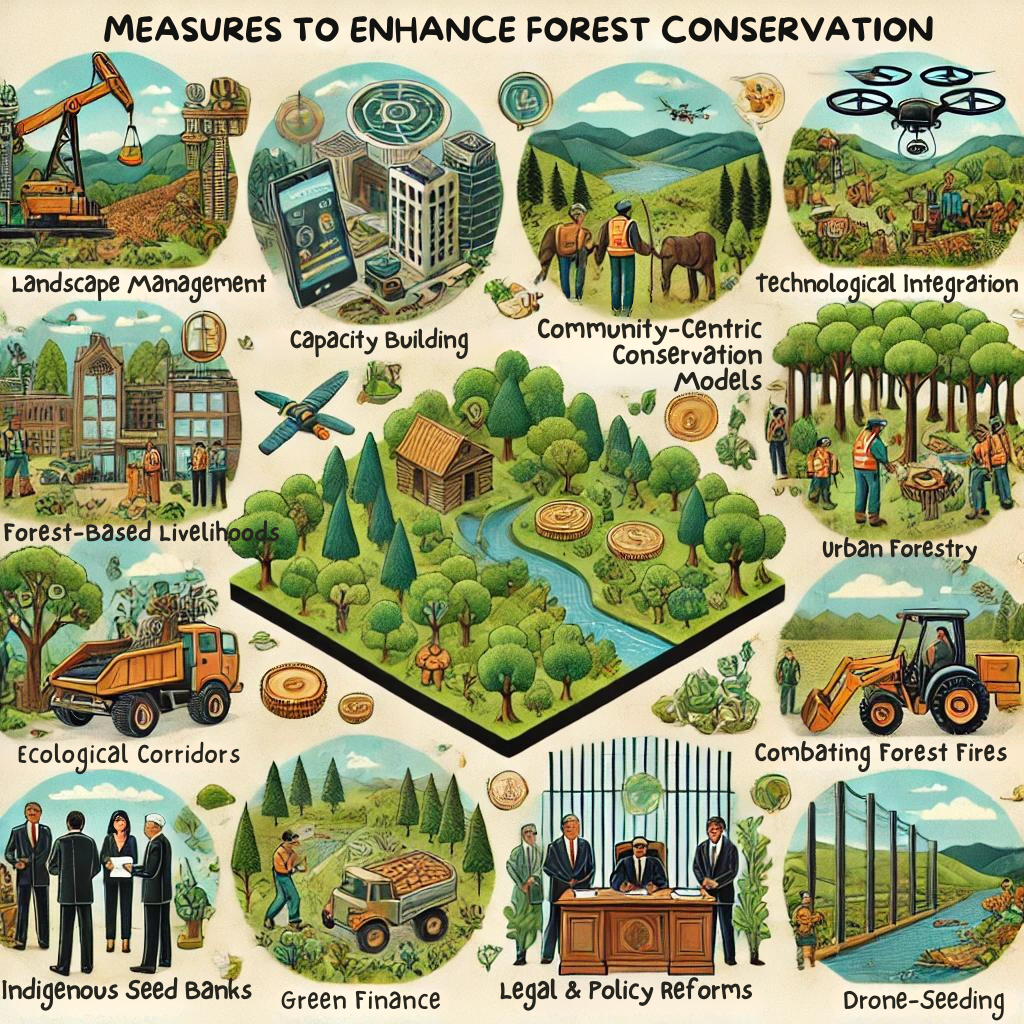The United Nations’ declaration of 2021–2030 as the Decade of Ecosystem Restoration has led to global efforts to combat deforestation and climate change, with tree planting becoming a popular strategy. Many large-scale initiatives have been launched worldwide, gaining media attention and public support. However, these mass tree-planting efforts have faced criticism for limited community involvement, inadequate post-planting care, and the promotion of monocultures. Experts warn that such approaches may not be as effective for carbon sequestration and biodiversity as intended.
Origin of the Article
The article “The issue with India’s tree planting schemes” published in The Hindu on 19/07/2024, highlights the challenges in India’s forest conservation efforts. It points out the degradation of forest landscapes due to unsustainable practices and emphasizes the need for effective tree-planting and ecosystem restoration strategies. The article stresses the importance of community participation, post-planting measures, and technical considerations for sustainable environmental conservation.
Relevancy for UPSC Students
Understanding the topic of forest conservation is crucial for UPSC students. It relates to the General Studies Paper II and III, covering issues of development, forest resources, and environmental management. This knowledge can aid in answering questions on environmental policies and sustainable development in the examination.

Why in News
The topic of India’s tree planting schemes is in the news due to mounting scrutiny over their effectiveness and sustainability. This issue is significant for UPSC aspirants as it intersects with key areas like environmental conservation, community participation, and sustainable development. Understanding the complexities of forest conservation and the limitations of current approaches can aid in answering questions related to GS Papers 2 and 3, as well as in the essay section. Analyzing this topic helps aspirants connect past questions on forest policies, biodiversity, and climate change mitigation with ongoing debates and policy measures.
Significance of Forests for India
Forests in India play a crucial role in maintaining biodiversity, mitigating climate change, supporting livelihoods, providing essential ecosystem services, and holding cultural and spiritual significance. They are indispensable for the ecological and socio-economic well-being of the country, making their conservation a national priority.
Biodiversity Conservation
India is home to over 47,000 species of plants and 81,000 species of animals, according to the Ministry of Environment and Forests. This rich biodiversity, including unique species like the Namdapha flying squirrel, highlights the country’s status as a global biodiversity hotspot. Protecting these species is vital for maintaining ecological balance and supporting life systems.
Climate Change Mitigation
Forests act as significant carbon sinks, absorbing CO2 emissions and helping mitigate climate change. India’s commitment to creating an additional carbon sink of 2.5–3 billion tonnes of CO2 equivalent by 2030 underscores the importance of forest conservation. Initiatives like the Green India Mission aim to increase forest cover and contribute to global climate goals.
Livelihood Support
Forests are a lifeline for over 250 million people in India, including tribal communities. The Forest Rights Act and schemes like Van Dhan Yojana are designed to enhance forest-based livelihoods sustainably. Successful programs such as the Tendu Patta collection in Madhya Pradesh demonstrate the economic benefits of well-managed forests for local communities.
Ecosystem Services
Forests provide invaluable ecosystem services, including air purification, soil conservation, and pollination, which are essential for human survival and economic activities. Initiatives like the Economics of Ecosystems and Biodiversity (TEEB) are reshaping forest management policies to better value these services, reflecting their true worth to society.
Cultural and Spiritual Significance
Forests hold deep cultural and spiritual value for many Indian communities, supporting traditional knowledge systems and practices. The recognition of sacred groves under the Biological Diversity Act helps protect these culturally significant areas. Efforts to document traditional ecological knowledge, such as in the Nilgiris Biosphere Reserve, highlight the intertwined nature of cultural preservation and forest conservation.
Major Challenges Faced by Forests in India
Despite their significance, forests in India face numerous challenges, including deforestation, human-wildlife conflict, and legislative loopholes, which hinder conservation efforts.

Deforestation and Forest Degradation
India continues to lose forest cover due to development projects, mining, and agriculture expansion. The Forest Survey of India 2021 report revealed a decrease in moderately dense forest area by 1,582 sq km. Controversial projects like the Aarey forest clearing and the Ken-Betwa River linking project exemplify the ongoing conflict between development and conservation.
Human-Wildlife Conflict
The shrinking and fragmentation of forest habitats have led to increased human-wildlife conflicts. Statistics show that over 500 people and 100 elephants die annually due to such conflicts. Frequent leopard encounters in Maharashtra’s human settlements illustrate the severity of this issue.
Plantation Vs Conservation
Monoculture plantations often harm biodiversity and ecosystem health, lacking the diversity needed for resilient ecosystems. These drives frequently ignore local ecological needs, sometimes planting trees in inappropriate areas, which can disrupt existing habitats and exacerbate problems like wildfires. Post-planting care is also often inadequate, leading to low survival rates.
Legislative Loopholes and Judicial Interventions
Recent amendments to the Forest Conservation Act of 1980, have sparked legal battles over India’s forest protection framework. Proposed changes that exempt certain forest lands recorded before 1980 from protection could lead to increased deforestation. This contradicts the Supreme Court’s 1996 verdict in the T.N. Godavarman Thirumulpad case, which ensured protection for all forests in government records.
Climate Change Impacts
Indian forests are increasingly vulnerable to climate change, facing altered precipitation patterns, increased forest fires, and pest outbreaks. The 2024 forest fires in Uttarakhand highlight this growing threat. Despite commitments under Nationally Determined Contributions, achieving carbon sink targets amid changing climatic conditions remains a challenge.
Invasive Species and Biodiversity Loss
Invasive species like Lantana camara in the Western Ghats and Senna spectabilis in Mudumalai Tiger Reserve are threatening native biodiversity. These species alter ecosystem dynamics and outcompete native flora, leading to the decline of native grasslands and other critical habitats.
Funding and Resource Allocation Issues
Despite the importance of forests, funding for their conservation often falls short. The Compensatory Afforestation Fund Management and Planning Authority (CAMPA) funds, intended for afforestation, have faced underutilization and misallocation, hindering effective forest management and conservation efforts.
Shrinking Forest Corridors
Wildlife corridors, essential for animal movement and genetic diversity, are rapidly disappearing. The Kaziranga-Karbi Anglong corridor in Assam and the Kanha-Pench corridor in central India face fragmentation due to encroachment and infrastructure development, isolating animal populations, and intensifying human-wildlife conflicts.
PESTEL Analysis
| Political: The editorial highlights significant political challenges in forest conservation, such as legislative loopholes in the Forest Conservation Act and proposed exemptions that might lead to increased deforestation. Political will is crucial, as evidenced by the support for programs like the Green India Mission and the Forest Rights Act, which aim to enhance forest cover and secure community rights respectively. Economic: Forest ecosystems offer substantial economic benefits, providing livelihoods for over 250 million Indians and services valued in trillions of rupees. Financial mechanisms like Payment for Ecosystem Services (PES) and green bonds are suggested to fund conservation efforts effectively. However, issues like underutilization of the Compensatory Afforestation Fund signal economic inefficiencies that need addressing. Social: Forests have profound social implications, supporting tribal and rural communities. Effective conservation requires bolstering community-centric models, such as Van Panchayats and Community Forest Resource rights, which have demonstrated success in biodiversity conservation and forest regeneration. Technological: The integration of advanced technologies such as remote sensing, drones, and AI for real-time forest monitoring is vital. Expanding the use of satellite imagery by the Forest Survey of India can enhance conservation efforts and provide more accurate data for policy-making. Environmental: Environmental challenges include deforestation, degradation, human-wildlife conflicts, and the impact of climate change, which alters precipitation patterns and increases vulnerability to fires. Strategies such as ecological restoration and combating forest fires through early detection systems are crucial. Legal: There is a critical need for stronger legal frameworks to protect forests and wildlife corridors. The editorial suggests amending the Forest Conservation Act to provide clearer definitions and more robust protection measures, aligning with environmental conservation goals. |
Measures to Enhance Forest Conservation in India
Innovative and sustainable measures are needed to enhance forest conservation in India, address current challenges, and ensure long-term ecological health.
Integrated Landscape Management Approach
A holistic landscape-level conservation strategy that integrates forest conservation with sustainable land use practices is essential. The Terai Arc Landscape initiative is a successful model that connects fragmented habitats while addressing local livelihood needs, demonstrating the potential of such approaches.
Technological Integration in Forest Monitoring
Leveraging advanced technologies like remote sensing, drones, and AI-powered systems can enhance real-time forest monitoring and management. The Forest Survey of India’s use of high-resolution satellite imagery for forest cover assessment is a positive step, but expanding this to include IoT sensors for wildlife tracking can further bolster conservation efforts.
Community-Centric Conservation Models
Strengthening community forest management models like Van Panchayats and Community Forest Resource Rights has proven effective in forest regeneration and biodiversity conservation. The success of Mendha Lekha village in Maharashtra, which manages 1,800 hectares of forest, highlights the potential of community-led initiatives.
Green Finance and Market-Based Conservation Mechanisms
Developing innovative financing mechanisms, such as Payment for Ecosystem Services (PES) schemes, carbon credit markets, and green bonds, can support forest conservation. These market-based approaches ensure that beneficiaries of forest services contribute to their maintenance and restoration.
Urban Forestry and Green Infrastructure
Comprehensive urban forestry programs that create functional urban ecosystems are essential. Initiatives like the Yamuna Biodiversity Park in Delhi. It can restore ecosystem services and biodiversity and can serve as a model for integrating nature-based solutions in urban planning.
Strengthening Forest Governance and Capacity Building
Modernizing forest departments through capacity-building programs is crucial. Training forest staff in new technologies, community engagement, and interdisciplinary conservation approaches can enhance the effectiveness of forest governance.
Sustainable Forest-Based Livelihoods
Developing sustainable forest-based livelihoods can reduce dependency on destructive forest use. Expanding successful models like the Van Dhan Yojana and promoting eco-tourism initiatives managed by local communities can integrate conservation with economic development.
Restoration of Degraded Forests and Ecological Corridors
Launching nationwide programs for ecological restoration of degraded forests and critical wildlife corridors is essential. The successful transformation of the Aravalli Biodiversity Park from a mining wasteland to a thriving ecosystem demonstrates the potential of ecosystem-based approaches.
Legal and Policy Reforms for Enhanced Protection
Strengthening legal frameworks by addressing loopholes in existing laws and ensuring strict implementation is vital. Amendments to the Forest Conservation Act and developing a comprehensive national policy on wildlife corridors can provide legal protection to crucial forest areas.
Indigenous Seed Banks for Forest Restoration
Establishing community-managed indigenous seed banks to preserve local biodiversity and support forest restoration efforts is crucial. The Vrikshamitra model in Maharashtra, which collects and distributes seeds of native species, can be replicated across India.
Drone-Seeding for Difficult Terrains
Utilizing drone technology for seed dispersal in difficult-to-access areas can enhance reforestation efforts. This method is particularly effective for restoring mangrove forests and revegetating steep hillsides.
Combating Forest Fires
A multi-pronged approach to combating forest fires includes preventative measures like controlled burns, creating fire breaks, and community education. Early detection through advanced technology, well-equipped firefighting teams, and international collaboration can significantly improve fire response and management.

Conclusion
In conclusion, forest conservation in India requires a multifaceted approach that goes beyond mere tree planting. It calls for the integration of community participation, advanced technologies, and sustainable livelihood initiatives to create resilient ecosystems. As future UPSC servants, understanding these complexities and advocating for ecologically sensitive policies is crucial to shaping our nation.
| UPSC Civil Services Examination, Previous Year Questions (PYQs) Mains Q. Discuss the Namami Gange and National Mission for Clean Ganga (NMCG) programs and the causes of mixed results from the previous schemes. What quantum leaps can help preserve the river Ganga better than incremental inputs? (GS Paper III, 2015) Q. The Ken-Betwa River linking project is seen as a critical initiative for water management in India. Discuss the potential benefits and environmental concerns associated with this project. How can these concerns be mitigated? |

